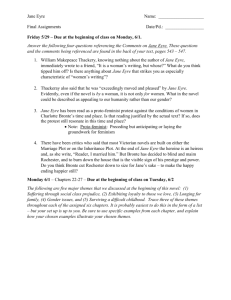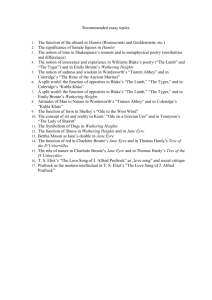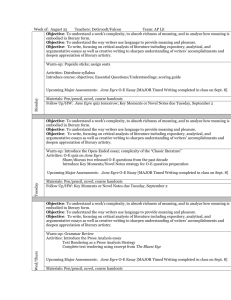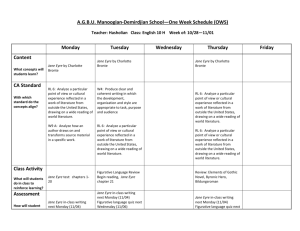Overview
advertisement
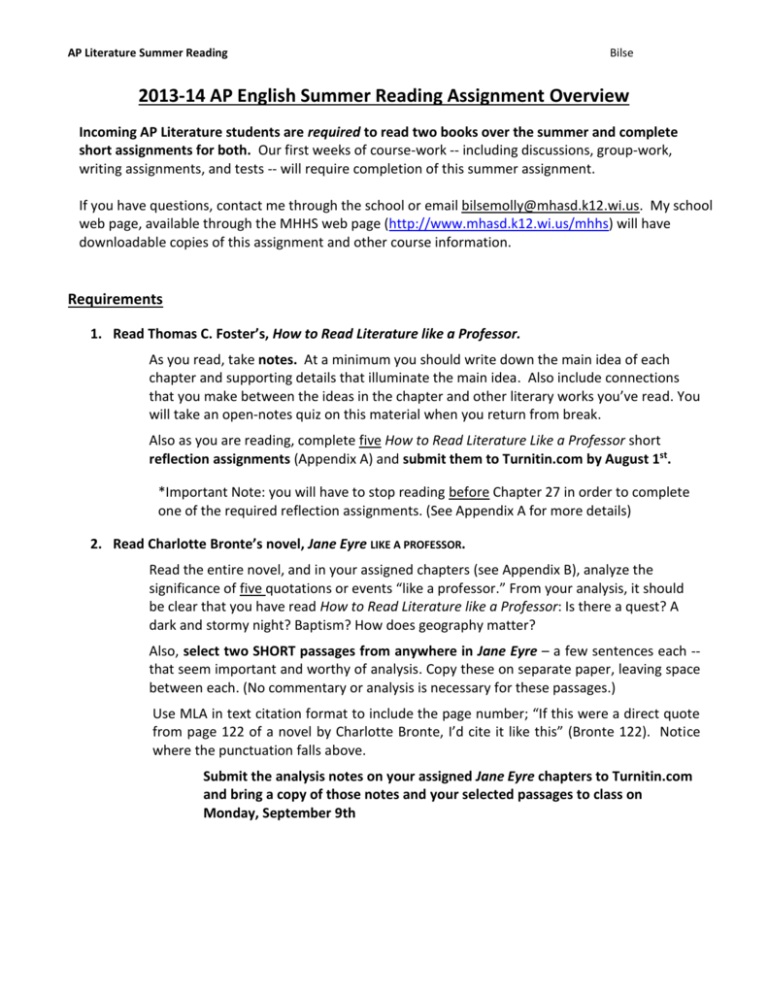
AP Literature Summer Reading Bilse 2013-14 AP English Summer Reading Assignment Overview Incoming AP Literature students are required to read two books over the summer and complete short assignments for both. Our first weeks of course-work -- including discussions, group-work, writing assignments, and tests -- will require completion of this summer assignment. If you have questions, contact me through the school or email bilsemolly@mhasd.k12.wi.us. My school web page, available through the MHHS web page (http://www.mhasd.k12.wi.us/mhhs) will have downloadable copies of this assignment and other course information. Requirements 1. Read Thomas C. Foster’s, How to Read Literature like a Professor. As you read, take notes. At a minimum you should write down the main idea of each chapter and supporting details that illuminate the main idea. Also include connections that you make between the ideas in the chapter and other literary works you’ve read. You will take an open-notes quiz on this material when you return from break. Also as you are reading, complete five How to Read Literature Like a Professor short reflection assignments (Appendix A) and submit them to Turnitin.com by August 1st. *Important Note: you will have to stop reading before Chapter 27 in order to complete one of the required reflection assignments. (See Appendix A for more details) 2. Read Charlotte Bronte’s novel, Jane Eyre LIKE A PROFESSOR. Read the entire novel, and in your assigned chapters (see Appendix B), analyze the significance of five quotations or events “like a professor.” From your analysis, it should be clear that you have read How to Read Literature like a Professor: Is there a quest? A dark and stormy night? Baptism? How does geography matter? Also, select two SHORT passages from anywhere in Jane Eyre – a few sentences each -that seem important and worthy of analysis. Copy these on separate paper, leaving space between each. (No commentary or analysis is necessary for these passages.) Use MLA in text citation format to include the page number; “If this were a direct quote from page 122 of a novel by Charlotte Bronte, I’d cite it like this” (Bronte 122). Notice where the punctuation falls above. Submit the analysis notes on your assigned Jane Eyre chapters to Turnitin.com and bring a copy of those notes and your selected passages to class on Monday, September 9th AP Literature Summer Reading Bilse Why These Texts? o Why How to Read Literature Like a Professor? Understanding literature need no longer be a mystery… Professors and other informed readers see symbols, archetypes, and patterns because those things are there -- if you have learned to look for them. As Foster says, you learn to recognize the literary conventions the "same way you get to Carnegie Hall. Practice" (xiv). o Why Jane Eyre? Well, aside from being tied as the 3rd most frequently listed work on the Free Response Question of the AP Exam, check out what Shmoop.com has to say: When you look at Jane Eyre, you might just see a long novel about a gal in an ugly gray dress whose life – a lot of the time – totally sucks. Whether she’s gagging on burned porridge at her horrible boarding school or…wandering around on the moor starving to death, life is often painful for Jane. The thing is, it’s not painful to read about it. In fact, we start to get kind of obsessed with all the gory details after a while. … Will Jane marry her cousin or agree to bigamy? Is there a ghost at Thornfield Hall or is it a vampire? They could make a reality show out of this; it would be like Supernanny + The Bachelorette + Ghost Hunters. Of course, apart from the whole thirst-for-voyeurism thing that we all have, Jane Eyre also about something else: The Man getting you down. Over and over, Jane’s put into situations where she’s too young, too poor, or too powerless to win, but she has to try anyway, and we all know about that. We’ve all been the kid who was completely mistreated by some random adult like Mrs. Reed or Mr. Brocklehurst just because that person has a stick up you-know-where. We’ve all had to accept that everyone would believe the adults just because they are adults, so they get away with it. Maybe some of us have also been the young employee who gets pressured to do something immoral by our boss. Or the girlfriend who finds out that her boyfriend’s taking someone else out on Friday night. That "someone else" might not be an insane vampiric arsonist, but hey, parallels only go so far. What we’re trying to say is: half of Jane Eyre is pure get-the-popcorn omigosh-she-didn’t spectacle, and the other half is looking pretty familiar. Note from Mrs. Bilse: Don’t let the length of Jane Eyre intimidate you. It’s the longest book we read all year, so we get it over with first. Stick with it! Get Jane through Low Wood (a “low point” in reader entertainment) and then the real DRAMA begins! AP Literature Summer Reading Bilse Appendix A: How to Read Literature like a Professor Writing Assignments These short writing assignments will let you practice your literary analysis and they will help me get to know you, your writing, and your literary tastes. Whenever I ask for an example from literature, you may use short stories, novels, plays, or films. (If your literary repertoire is thin and undeveloped, use the book’s appendix to jog your memory or to select additional works to explore. At the very least, watch some of the "Movies to Read" that are listed on pages 293-294.) Please note that your responses should be paragraphs -- not pages! Remember to capitalize and punctuate titles properly for each genre. (A poem or short story is in quotation marks, while longer works --like a novel, play, movie, or television-- series are italicized.) Complete responses to five of these questions. Underlined/* chapters are required and you should select three other chapter topics to explore. Submit responses to Turnitin.com by August 1. (Turnitin.com Class ID: 6523527 Password: read) Introduction: How'd He Do That? How does the recognition of patterns/symbols make it easier to read complicated literature? Discuss a time when your appreciation of a work was enhanced understanding symbol/pattern. *Chapter 1: Every Trip Is a Quest (Except When It's Not) List the five aspects of the QUEST and then apply them to something you have read (or viewed) in the form used on pages 3-5. Chapter 2: Nice to Eat with You: Acts of Communion Choose a meal from a literary work and apply the ideas of Chapter 2 to this literary depiction. Chapter 3: Nice to Eat You: Acts of Vampires What are the essentials of the Vampire story? Apply this to a literary work you have read or viewed. alludes to or reflects Shakespeare. Show how the author uses this connection thematically. Chapter 8: Hanseldee and Greteldum Think of a work of literature that reflects a fairy tale. Discuss the parallels. Does it create irony or deepen appreciation? Chapter 9: It's Greek to Me Write a free verse poem derived or inspired by characters or situations from Greek mythology. Chapter 10: It's More Than Just Rain or Snow Discuss the importance of weather in a specific literary work, not in terms of plot. Chapter 11: ...More Than It's Gonna Hurt You: Concerning Violence Present examples of the two kinds of violence found in literature. Show how the effects are different. Chapter 12: Is That a Symbol? Chapter 4: If It's Square, It's a Sonnet Use the process described on page 106 and Select a sonnet and show which form it is. Discuss investigate the symbolism of the fence in "Araby." how the content reflects the form. (Submit a copy (Mangan's sister stands behind it.) of the sonnet, marked to show your analysis). Chapter 13: It's All Political Chapter 5: Now, Where Have I Seen Her Before? Assume that Foster is right and "it is all political." Define intertextuality. Discuss three examples that Use his criteria to show that one of the major have helped you in reading specific works. works assigned to you in high school (Romeo and Chapter 6: When in Doubt, It's from Juliet, Of Mice and Men, To Kill a Mockingbird, A Shakespeare... Midsummer Night’s Dream, something from Discuss a work that you are familiar with that American Lit…) is political. AP Literature Summer Reading Bilse Chapter 14 -- Yes, She's a Christ Figure, Too Apply the criteria on page 119 to a major character in a literary work. Choose a character that will have many matches. This is a particularly apt tool for analyzing film -- for example, Star Wars, Cool Hand Luke, Excalibur, Malcolm X, Braveheart, Spartacus, Gladiator and Ben-Hur. Chapter 21: Marked for Greatness Figure out Harry Potter's scar. If you aren't familiar with Harry Potter, select another character with a physical imperfection and analyze its implications for characterization. Chapter 22: He's Blind for a Reason, You Know, Chapter 23: It's Never Just Heart Disease... Chapter 15: Flights of Fancy Chapter 24: ...And Rarely Just Illness Select a literary work in which flight signifies Recall two characters who died of a disease in a escape or freedom. Explain in detail. literary work. Consider how these deaths reflect Chapter 16/17: It's All About Sex...Except the Sex the "principles governing the use of disease in literature" (215-217). Discuss the effectiveness of OK ..the sex chapters. The key idea from this the death as related to plot, theme, or symbolism. chapter is that "scenes in which sex is coded rather than explicit can work at multiple levels and Chapter 25: Don't Read with Your Eyes sometimes be more intense that literal depictions" After reading Chapter 25, choose a scene or (141). In other words, sex is often suggested with episode from a novel, play or epic written before much more art and effort than it is described, and, the twentieth century. Contrast how it could be if the author is doing his job, it reflects and creates viewed by a reader from the twenty-first century theme or character. Choose a novel or movie in with how it might be viewed by a contemporary which sex is suggested, but not described, and reader. Focus on specific assumptions the author discuss how the relationship is suggested and how makes that would not make it in this century. this implication affects the theme or develops Chapter 26: Is He Serious? And Other Ironies characterization. Select an ironic literary work and explain the Chapter 18: If She Comes Up, It's Baptism multivocal nature of the irony in the work. Think of a "baptism scene" from a significant *Chapter 27: A Test Case literary work. How was the character different Read "The Garden Party" by Katherine Mansfield, after the experience? Discuss. the short story starting on page 245. Complete the Chapter 19: Geography Matters... exercise on pages 265-266, following the Discuss at least four different aspects of a specific directions exactly. Then compare your writing with literary work that Foster would classify under the three examples. How did you do? What does "geography." the essay that follows comparing Laura with Chapter 20: ...So Does Season Persephone add to your appreciation of Find a poem that mentions a specific season. Then Mansfield's story? discuss how the poet uses the season in a Envoi meaningful, traditional, or unusual way. (Submit a Choose a motif not discussed in this book (as the copy of the poem with your analysis.) horse reference on page 280) and note its Interlude: One Story appearance in three or four different works. What Write your own definition for archetype. Then does this idea seem to signify? identify an archetypal story and apply it to a literary work with which you are familiar. Adapted from assignments originally developed by Donna Anglin. AP Literature Summer Reading Bilse Appendix B: Jane Eyre Quotation Analysis Examples and Chapter Assignments *Quotation Analysis Example: first chapter of Jane Eyre (notes by Charlie Nettesheim)* FORMAT for analysis/commentary assignment: a. Quotation, Symbol, Theme or Point of Interest (with MLA in-text citation) b. Analysis and Commentary (showing understanding of Foster’s ideas) a. “…the cold winter wind had brought with it clouds so somber, and rain so penetrating, that further outdoor exercise was not out of the question. I was glad of it: I never liked long walks” (Bronte 11). b. Almost immediately, weather and season are set into play, but along with them is irony. The weather, while terrible, seems to bring Jane joy, and if there is any truth in foreshadowing, this book will likely be very depressing. a. “John Reed was a school-boy of fourteen years old… large and stout for his age, with a dingy and unwholesome skin” (Bronte 13). b. Immediately your radar goes off while reading the before, during, and after of this description, but John Reed, while cruel and quite ugly, doesn’t fit the devil “norm.” He’s just not smart enough, and he doesn’t tempt: he demands. a. “He ran headlong at me; I felt him grasp my hair and my shoulder: he had closed with a desperate thing” (Bronte 15). b. Violence almost always has a point. This is no exception. Reed’s “tender ministrations” serve as a catalyst for Jane’s cathartic release, which, unfortunately, sends her to the red room and puts the plot into overdrive. Jane Eyre Quotation and Analysis Chapter Assignments While you need to read the whole book, your five pairs of Quotation Analysis notes should cover only your assigned chapters. Last names beginning A-F G-L M-P Q-Z Chapters 2-11 Chapters 12-20 Chapters 21-27 Chapters 28-36

